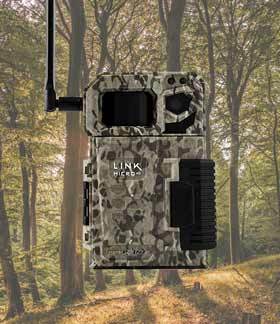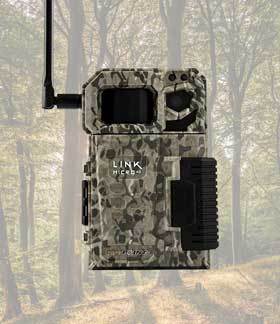
In addition to the price of the camera, you also need to purchase a data plan in order to have the images sent to you. If you have multiple cameras or have a camera placed in an area with a lot of activity the price of sending all those images can add up as well.
If you are a budget-conscious buyer who is looking for an affordable cellular trail camera the super-compact SPYPOINT Link-Micro might be a good option for you.
- TECHNOLOGY: SMALLEST cellular trail camera in the market! Powered by only 8 AA batteries and MicroSD card. Smaller than your hand! BUCK TRACKER - AI Image Recognition. Mobile app & web app capable with photo viewing on smartphone & computer
- CELLULAR: 4G Photo transmission, works with major cellular providers nationwide, see Coverage Maps for performance. Preactivated SIM, mobile app capable, simple and fully configuration with app. Data plans available
- PICTURE QUALITY: 10 MP, 4 Power LEDs, up to 80' Flash and Detection Range, 0.5s Trigger Speed, color photos by day, infrared by night, Multi-Shot and Continuous Modes
- POWER: 16GB MicroSD memory card (not included), 8 AA batteries (not included), 12V jack Network 4G (HSPA+)
Table of Contents
So Is It Possible to Find a Good Compact Cellular Trail Camera on a Budget?
Making an affordable cellular trail camera is exactly what SPYPOINT was trying to do when they made the Link-Mirco. They already have some terrific full-featured cellular trail camera options available, but this was their attempt to make a more compact entry-level model that could still meet peoples’ needs.
They went about trying to achieve this goal by doing 3 different things.
- They tried to identify the features that were most important to people who were thinking of buying a cellular trail camera and include just those. By eliminating those non-essential features they could keep the price of the camera low.
- They wanted to keep the size of the camera small. This is especially helpful if you plan on using the camera for surveillance or if you plan on posting it on public hunting land where people might be tempted to steal it.
- They combined this camera with their flexible low-cost data plans because having an affordable trail cellular trail camera doesn’t help if you can’t afford to use it because the data plan is too expensive.
Introducing the SPYPOINT Link-Micro Trail Camera
The SPYPOINT Link-Micro trail camera is currently the smallest cellular trail camera on the market. This 4G cellular trail camera comes in both an AT&T and a Verizon version.
The Link-Micro is very easy to set up and use. The camera comes with a free customizable app that allows you to adjust the camera’s settings to help ensure you get the best images regardless of where you set it up. Plus, it is backed by SPYPOINT’s 2-year warranty.
Some people feel that the case and antenna don’t feel as sturdy as some other trail camera options that are out there, but if you don’t abuse the camera everything should be just fine. Plus, we are talking about a camera that is less than half the size of most of the competition and is coming in at a lower price as well. So it probably isn’t fair to expect it to look and feel indestructible.
Pros
- Very affordable
- 80 foot detection range
- 80 foot flash range
- 0.5 second trigger speed
- Free smartphone app
- Compact size with dimensions of 3.1″ W X 4.4″ H X 2.2″ D
- Image stamp with date, time, moon phase and temperature
- Mount and strap are included for convenient setup
Cons
- No color viewing screen
- No video mode
- 10MP camera
- No time-lapse mode
- No Bluetooth connectivity
Review of Key Features and Benefits of the SPYPOINT Link-Micro
Camera
The Link-Micro has a multi-shot mode that allows for up to 2 shot each time the camera is triggered and the 10MP camera that comes with this trail camera does a good job, but let’s be honest it isn’t going to compete with some of the higher-end models that now often boast about having cameras with 20 or more megapixels.
That being said, a 10MP camera will more than do the job. This is because cellular trail cameras will compress and reduce the quality of the picture before it sends it to you. They do this in an effort to save you money on your data plan. So having a top of the line camera on is wasted for users as they look at the images that are sent to them.
The Link-Micro doesn’t record video, but this shouldn’t be viewed as a big drawback since most cellular trail cameras don’t transmit video clips over cellular networks.
Motion Sensor
The 80 foot detection range is more than adequate. In fact, it is better than many of the best selling models that are currently out there.
The motion sensor on the LINK-MICRO also comes with adjustable sensitivity levels. The high, medium, and low lettings will allow you to customize the camera’s performance for a wide variety of environments.
Trigger Speed
The 0.5 second trigger speed is respectable and should meet your needs in almost every situation, but there are a lot of trail cameras out there with trigger speeds of less than 0.5 seconds.
For those who are new to trail cameras, It is probably worth noting that just a few years ago people were pretty excited to see trail cameras with trigger speeds of 1 second or less. So even though you can find faster trigger speeds, a speed of 0.5 isn’t bad.
Flash
The Link-Micro has a low glow flash and despite only having 4 LEDs it has an impressive flash range of 80 feet.
To make it even better SPYPOINT has given this camera an adjustable flash. This is a very helpful feature. If the object being photographed is relatively close to the camera you will want to keep it in Night Mode (lower setting) to prevent the subject from looking washed out. If the object being photographed is further away from the camera and doesn’t seem to be illuminated quite enough you can switch the flash to Enhanced mode to increase the strength of the LEDs.
Remember that the infrared LEDs will glow red when the flash is in use. This glowing doesn’t spook game animals, but it can give away the camera’s location to people if they are looking at the camera when the flash is being activated. So if you need to keep the camera’s location concealed or want to put it in an area where you worry about it being stolen you might want to consider a more expensive model with no glow flash.
If you want to learn more about the different types of flash available on trail cameras click here.
Smartphone App
Included with the Link-Miro is SPYPOINT’s free app that includes live customer support, cloud storage, GPS Geotagging, and the popular Buck Tracker image recognition software.
Data Plan
SPYPOINT currently offers 4 flexible data plans to meet your needs including a free image plan available that allows you to transmit up to 100 free images each month. There are no activation fees for any of these plans (unlike what you might expect with a cell phone).
You have the choice to go month-to-month with these plans, which is great if you only want to use the camera for a few months each year. If you plan on using the camera year round they offer you a discount if you pay for the year upfront. For example, at the time of writing this review, the most expensive unlimited plan is $15 a month if you go month-to-month and averages out to $10 per month if you pay for the entire year upfront.
Battery Life
Talking about battery life is always difficult because the amount of traffic you have in the area where you post the camera and the settings you choose can have a large impact on battery life. So it is hard to get an apples-to-apples comparison.
That being said, if you set the camera up in a high traffic area and have the camera transmit pictures to you immediately you should feel safe to expect to get between 1 to 2 months of battery life off of a set of 8 AA lithium batteries. However, if you are OK with having the flash set to the lower intensity setting and set the camera to transmit images less frequently (every 2, 4, 6, or 12 hours) you could significantly extend the battery life.
Input for External 12V Power Supply
If you want to leave the camera unattended for long periods of time and don’t want to worry about the batteries dying, know that the Link-Mirco has a 12V DC power supply input and is compatible with the SPYPOINT 12V Battery, Charger & Housing Kit as well as the SPYPOINT Solar Panel.
Dimensions
As we have already mentioned, one of this SPYPOINT model’s selling points is its small dimensions. Measuring 4.33” x 3.5” x 2.0” the Link-Mirco is very compact, especially when compared to other cellular trail cameras. In fact, its compact size puts it on par with mini trail cameras that don’t offer cellular connectivity.
Time-Lapse Feature
There is no time-lapse feature with this camera.
For those of you who are unfamiliar with the time-lapse feature that is found on some trail cameras, here is a quick summary of what it does and why it is important. Trail cameras capture images of subjects or activity that are within the range of its motion sensor, but unless the motion sensor is triggered the activity taking place beyond the range of the motion sensor is never recorded. Cameras with a time-lapse feature can take images at predetermined intervals without needing the motion sensor to be triggered. This gives you a greater chance of capturing activity that is further away from the camera. An example of when the time-lapse feature would be useful is when someone wants to post a camera on the edge of a large field.
The time-lapse feature isn’t as popular among cellular trail camera users because you usually end up with a lot of pictures of nothing. However, transmitting all those empty pictures means that you will need to spend more money on a data plan. Plus, transmitting all those extra pictures will lessen your battery life. So the fact that this SPYPOINT camera doesn’t have a time-lapse feature won’t bother most people.
LCD Screen
Because of its small size, the Link-Micro doesn’t have an LCD screen to use when setting up the camera or to allow you to preview pictures the camera has taken.
It gets around the lack of an LCD screen by having all the camera settings handled through the free SPYPOINT app. Plus, by not having an LCD screen SPYPOiNT was able to keep the size of the trail camera smaller as well as keep the cost down.
Image Stamp
The image stamp is pretty standard for what you expect on trail cameras these days. It includes the date, time, moon phase, and temperature.
Memory Card
The Link-Micro supports microSD cards (up to 32 GB capacity). We are not big fans of microSD cards. They work just fine, but are just too small and too easy to drop when switching out the memory card in the field. We prefer the larger and easier to handle standard sized SD cards, which is what most trail cameras use.
If you want to view the full-sized images the camera captures know that they are stored on the memory card (even if the compressed version has already been sent to you). It is also good to know that even if your data plan runs out because you have reached the limit for the number of pictures you the camera is allowed to send, that the camera is still taking pictures on the microSD card. So if you plan on leaving the camera unattended for long periods of time, make sure that you buy a 32GB microSD card.
Price
The competitive price is one of the strongest points for this trail camera. This low-cost model has allowed people, who otherwise wouldn’t have even considered it, to be able to buy a cellular trail camera.
Other Options
If you want to look at some other cellular trail camera options you might want to check out our Best Cellular Trail Camera Reviews and Buying Guide. Here are the cellular trail cameras we featured in that article.
Final Thoughts
While its flash range, detection range, and trigger speed are solid and will satisfy most people’s needs there are other cameras with better specs in these areas. That being said, let’s remember this trail camera’s strengths. It is super affordable and is the smallest cellular trail camera on the market. Plus, it has flexible data plans that are very affordable.
If you are looking for an affordable entry-level trail camera that you can feel comfortable putting on public land, or in a place where it might get stolen, the SPYPOINT Link-Micro is hard to beat.
- TECHNOLOGY: SMALLEST cellular trail camera in the market! Powered by only 8 AA batteries and MicroSD card. Smaller than your hand! BUCK TRACKER - AI Image Recognition. Mobile app & web app capable with photo viewing on smartphone & computer
- CELLULAR: 4G Photo transmission, works with major cellular providers nationwide, see Coverage Maps for performance. Preactivated SIM, mobile app capable, simple and fully configuration with app. Data plans available
- PICTURE QUALITY: 10 MP, 4 Power LEDs, up to 80' Flash and Detection Range, 0.5s Trigger Speed, color photos by day, infrared by night, Multi-Shot and Continuous Modes
- POWER: 16GB MicroSD memory card (not included), 8 AA batteries (not included), 12V jack
- BUCK TRACKER is an AI solution powered by SPYPOINT, trained to recognize and analyze your trail camera photos by species and gender*. BUCK TRACKER is complimentary for SPYPOINT users (FORCE, SOLAR & LINK series). Use BUCK TRACKER on the SPYPOINT APP
Last update on 2024-04-19 at 00:55 / Affiliate links / Images from Amazon Product Advertising API











